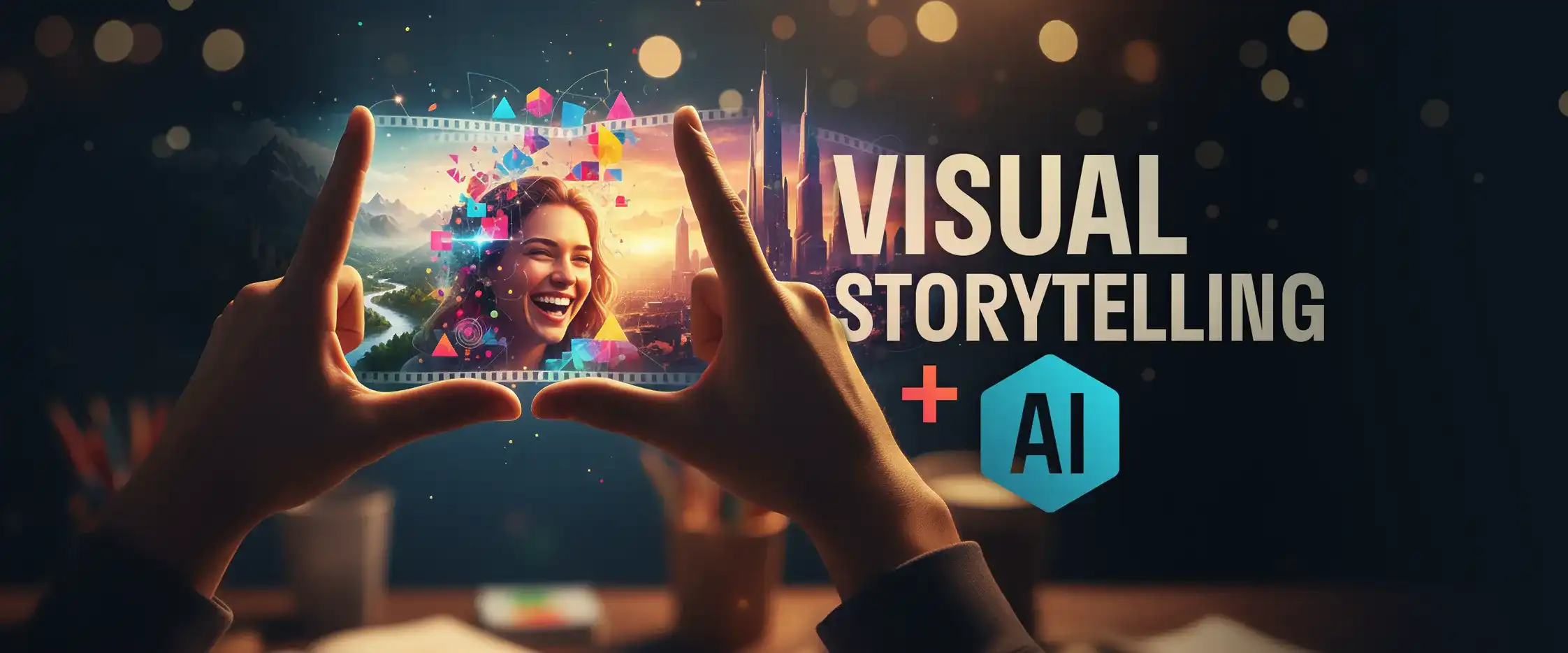AI is an undeniable key ingredient in modern marketing. It has become a powerful tool for generating text, images, social content, video, animation, and even website code, and it plays a role in just about every marketing and advertising campaign. From simple photo fixes to generating cinematic video clips, AI is used in ways both small and large to help move ideas from concept to campaign. Even this article you are reading now was created with some help from AI.
In this new landscape, where machines have a mechanical hand in crafting everything we see, it seems fair to ask whether visual storytelling is still a human-centric skill. Are we still the ones pulling the levers and fine-tuning each message, image, and web page? Or is AI now telling the story and shaping how we see the things around us, while we accept our reduced roles in crafting these marketing stories?

Before we answer that, let’s define visual storytelling:
Visual storytelling is the process of using visual media to communicate an idea, a message, or support a narrative. It’s a way of telling a story primarily through images, with or without supporting text, audio, or other elements. Ideally this allows brands to tap into the human brain’s natural ability to process visual information quickly and to take advantage of an emotional response. Visual storytelling often leans on nostalgia, memorable moments, or other deeply personal thoughts or positions on subjects.
Some key elements of visual storytelling are:
- Imagery: Compelling and relevant visuals.
- Composition: The arrangement of elements.
- Color and Lighting: Used to set the mood, convey symbolism, and draw attention.
- Narrative Structure: A clear beginning, middle, and end, or a cohesive sequence of visuals.
- Emotional Resonance: The ability to connect with the audience’s feelings.
Here are some examples of highly successful visual storytelling:
Fjällräven
The Fjällräven brand has always been based on a commitment to timeless design, durability, and sustainability. They value longevity and want customers to be confident in their products lasting a long time, sometimes being passed on from one generation to the next. This is in stark contrast to the modern manufacturing culture of planned obsolescence and the often clear intent to sell customers replacement products with shorter lifespans. Fjällräven has continued to highlight this part of their story by using imagery in their marketing that shows decades of Fjällräven products in use across generations of outdoor enthusiasts. The products don’t look very different today than they did in the 1960s when the company was founded. The website showcases vintage product ads that tout some of the same classic features and functionality of Fjällräven products that are still valued in their new releases today.


Coca-Cola
Coca-Cola has a long history of successful visual storytelling that taps into universal themes of happiness, togetherness, and celebration. Their fun campaigns, especially around the holidays, use vibrant colors and nostalgic imagery to create a consistent and emotionally resonant brand identity. They managed to memorably connect their product with Santa through years of consistent visual storytelling, and renewing that visual connection on a yearly basis has made Coke products synonymous with all things Christmas.
Their “Share a Coke” campaign, which used personalized beverage bottles, encouraged customers to create their own visual stories and share them, turning their product into a part of people’s personal memories through photos and social media posts.

Tingley
Tingley, a maker of rubber boots, overshoes, and work clothing, rely heavily on real photos showing real people using their products in industrial, manufacturing, construction, and recreational settings. Combining this strategy with references to an exceptionally long history as a family-owned business, “protecting generations since 1896,” the result is a truly authentic and relatable visual story that suggests longevity, trust, and reliability and helps to position Tingley as a company “rooted in history” and “inspired by innovation” as they look to the future with aspirations to provide quality products to more generations to come.
The company timeline on their website features images of products that have hardly changed in overall appearance and style in nearly 90 years, like their seamless rubber overshoes.
Tingley also is successful in another form of visual storytelling that attempts to relate to real-world problems customers have and provide solutions for them. Using imagery showing Tingley products being worn on muddy farm land, at cold winter work sites, and in rough outdoor terrain, allows the brand to suggest their products as the solution to real, tangible problems that many workers face.

Warby Parker
Warby Parker disrupted the eyewear industry with a visual brand that is stylish, modern, and celebrates diversity. They moved away from sterile, clinical visuals and instead crafted an aesthetic that is more like a fashion or lifestyle brand. Their visuals feature diverse people in everyday, authentic settings, making glasses feel less like a medical necessity and more like a fun personal accessory, something to celebrate rather than dread having to wear. Lifestyle photography is a bit warmer in tone, giving all of their images a more comforting and approachable look, further diminishing the sterile cool gray color temperature often associated with medical products.
Their commitment to social causes is also a core part of their visual story, with campaigns highlighting their “buy a pair, give a pair” program to get much needed glasses into the hands of people around the world who would otherwise be unable to purchase them. They showcase this with vibrant imagery of some of the beneficiaries of this global initiative.


So what does this mean for marketing in the age of AI?
Authenticity as Brand Currency
In a marketing world where AI can generate sometimes flawless, but often soulless, content, authenticity becomes a more valuable brand asset. Visual storytelling that feels real, raw, and unfiltered will stand out in a sea of AI slop. Even when the AI influence is less obvious, consumers are becoming more savvy and can still spot AI content mixed in among authentic brand visuals. Overuse of AI content erodes trust.
Highlighting a company’s history has always been helpful in establishing authenticity and authority, but in the age of AI, showing longevity and timelessness taps into an aspect of branding that AI doesn’t prioritize.
The true power of visual storytelling in the age of AI lies not in the “what,” but in the “why.” AI can help visualize the “what” in your campaign, but the “why” still needs to be developed from a human perspective.
Human Connection in a Digital World
AI excels at efficiency, but it can’t replicate the warmth of a shared human experience. A great visual story, told from a true human perspective, can cut through the algorithmic noise and create a genuine emotional connection. It’s the difference between a perfectly generated image of a sunset and one that captures the feeling of being there, enabled by products made by companies that have a history of crafting goods that can get you to that perfect sunset viewing location.
Conclusion
None of this is intended to suggest that AI should be kept out of visual storytelling. As a tool and a support mechanism for all aspects of marketing and advertising, AI is vitally important to the workflow of any brand or agency developing new campaigns.
While AI can create stunning images and videos with unprecedented speed and scale, it will never be able to replicate the value of visual storytelling as a powerful device. Visual storytelling is the emotional bridge between a brand and its audience, built on a foundation of shared experiences, nostalgia, social awareness, and empathy.
The future of telling these stories in marketing will be about collaboration, not competition. The key is in finding ways to leverage AI tools in appropriate places throughout the marketing process, while leaving the decisions that require a true human touch to actual humans.
AI can be a brilliant assistant, helping storytellers with general tasks, suggesting visual styles and concepts, or even generating preliminary content. This frees up the humans to focus on what they do best: crafting compelling narratives, filling them with emotion, and ensuring that they resonate with an audience on a deeply authentic level that helps them build credibility and trust for their brand.

